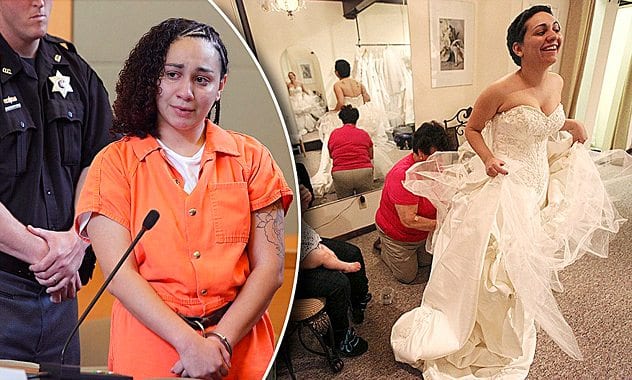 Mysteries
Mysteries  Mysteries
Mysteries  History
History 10 Surprising Stories About the Texas Rangers
 Humans
Humans 10 Philosophers Who Were Driven Mad by Their Own Theories
 Miscellaneous
Miscellaneous 10 Video-Game-Worthy Weapons and Armors from History
 Weird Stuff
Weird Stuff 10 Psychics Who Accurately Predicted Wartime Events
 The Arts
The Arts 10 Pieces of Art Inspired by a Broken Heart
 Health
Health 10 Science Fiction-Sounding New Medical Treatments
 History
History 10 Surprising Facts About the Father of Submarine Warfare
 Space
Space Ten Astonishing New Insights into Alien Worlds
 Weird Stuff
Weird Stuff 10 Bizarre Summer Solstice Rituals Still Practiced Today
 Mysteries
Mysteries Top 10 Haunting Facts About the Ghost Ship MV Alta
 History
History 10 Surprising Stories About the Texas Rangers
 Humans
Humans 10 Philosophers Who Were Driven Mad by Their Own Theories
Who's Behind Listverse?

Jamie Frater
Head Editor
Jamie founded Listverse due to an insatiable desire to share fascinating, obscure, and bizarre facts. He has been a guest speaker on numerous national radio and television stations and is a five time published author.
More About Us Miscellaneous
Miscellaneous 10 Video-Game-Worthy Weapons and Armors from History
 Weird Stuff
Weird Stuff 10 Psychics Who Accurately Predicted Wartime Events
 The Arts
The Arts 10 Pieces of Art Inspired by a Broken Heart
 Health
Health 10 Science Fiction-Sounding New Medical Treatments
 History
History 10 Surprising Facts About the Father of Submarine Warfare
 Space
Space Ten Astonishing New Insights into Alien Worlds
 Weird Stuff
Weird Stuff 10 Bizarre Summer Solstice Rituals Still Practiced Today
Top 10 Brazen Female Cons, Criminals, And Liars
This is a compilation of ten of the most debated and outrageous cases of women and their cons, crimes, and lies. Some of these cases were highly reported on and covered for months, even years. Others are less known but just as shocking.
10Rosemary Crossley: Facilitated Communication

In the early 1990s dozens of families with autistic children were ecstatic that after years of silence, their children could finally communicate through a process called facilitated communication. This technique involves a trained facilitator holding the autistic person’s arm while they type on a keyboard. Whether this process is legitimate or not, I suppose, is up for you to decide. But as more and more children started using facilitated communication, a disturbing number of family members were being accused of sexual abuse.
In 2007, 14-year-old Aislinn Wendrow accused her father, through facilitated communication, of sexually abusing her and her younger brother. Her father was arrested, and her brother was questioned by police for hours. He continually told police that none of it was true, that his father was not capable of such things, but after hours of brutal questioning the boy finally cracked under pressure and said that he was not sure, that maybe his father did do those things.
The Wendrow’s defense team hired Howard Shane, director of the Autism Language Program at Boston Children’s Hospital, to testify on their behalf. In 1994, Shane had worked with another family, the Wheatons, who experienced similar sexual abuse allegations from their daughter Betsy. In that case, Shane created a double-blind experiment to test the theory of facilitated communication. He showed one picture to the facilitator, Janyce Boynton, and a different picture to Betsy. Betsy was then asked to type what she had seen with Boynton’s help. In every instance, the word that Betsy typed matched the picture that only the facilitator had seen. Another key part of the trial was that Betsy had never learned how to read, write, or spell. Eventually, both Betsy and Aislinn’s fathers were relieved of all charges.
This debatable procedure was founded in 1974 by Rosemary Crossley. She was working as an assistant at the Mental Health Authority and decided to conduct a study with physically disabled children, which led her to create facilitated communication. Crossley’s work would spread like wildfire after a Syracuse University professor, Douglas Bilken, brought facilitated communication to the United States in 1990. By 1994 about 60 users of facilitated communication had made claims of sexual abuse. More and more experiments were conducted, similar to Shane’s, each one seeming to debunk the procedure as being credible. One showed that, among 126 people tested, only four subjects were found to have valid results.
Crossley was involved in many trials for herself and her facilitators. Along the way, she gained supporters and spectators. Over time, facilitated communication has progressed from what it was, even seemingly helping some families. However, many families were seriously scarred from its effects, no matter how good the intentions. So, I suppose it is for you to decide, Rosemary Crossley—a saint or a scam?
9Jessica Vega: Faked Cancer for Dream Wedding

In 2010, Jessica Vega, sporting short hair, visited a bridal shop and told the owner that she had terminal cancer and was hoping to get married as quickly as possible. The owner felt bad and helped her choose a dress, shoes, and a wig to cover her short hair free of charge.
Word of Jessica’s story spread, and it was picked up by the Times Herald-Record. Community members were soon jumping at the chance to help with her dream wedding. A reception venue, food, flowers, photography, and even a honeymoon to Aruba were all donated.
Four months later, her husband Michael O’Connell expressed to the newspaper that he thought the Doctor’s letter stating she had cancer was a fake. Jessica swore the doctor told her she had terminal leukemia, and that she was fighting the disease with water, diet, and exercise.
The couple soon divorced. Although Jessica pled not-guilty, she was charged with fraud and grand larceny. She spent two months in jail and was ordered to pay back $13,000 to the victims.
Water curing cancer is definitely an interesting theory. One could say that Vega was indeed sick, but cancer was not her ailment.
8Rachel Dolezal: Faked Being Black
Rachel Dolezal taught classes on African-American culture at Eastern Washington University, and she was the president of the Spokane NAACP—a civil rights group in which blacks and whites have worked together for over a hundred years. In 2015, Dolezal resigned from her post with the NAACP after it came to light that she had lied about her ethnicity.
It all started at Howard University (a historically black institution) where she received a master’s degree in fine art. She filed an unsuccessful discrimination suit against the university, claiming she felt discriminated against. Then, in 2015, she filed multiple reports of hate crimes. She told police that she found a threatening letter in the civil rights group’s post office box. Detectives determined that since there was no bar code or time stamp on the envelope, someone with access to the locked mailbox must have planted it there. There were three other confirmed incidents in which police could not prosecute anyone due to the lack of evidence. Dolezal claims there were at least eight hate crimes targeting her and her children.
In addition, she had listed herself as white, black, and American Indian on an application to serve on the police department’s ombudsman commission. There was also a picture posted on the Spokane NAACP chapter’s Facebook page of her beside a black man, who she claimed was her father.
She was soon outed by her parents as being white, not black. The couple, who are clearly white, had two biological children, including Rachel, and four adopted African-American children. Dolezal claims that growing up, she would color herself using a brown crayon, and she identified more with the African-American children. In a recent interview, her parents refuted all of her bizarre claims from her childhood. Dolezal now claims to be trans-black and has not filed any more reports of hate crimes.
7Linda Taylor: Welfare Queen

In 1976, Ronald Reagan, the former governor of California and the New Hampshire Republican presidential candidate, continually spoke of welfare abuses during his campaign. Particularly, one 47-year-old woman from Chicago, who he said had 80 names, 30 addresses, 12 Social Security cards, and collected veterans benefits from four fictional deceased husbands. He said she was receiving food stamps and collecting welfare under each of her names. Her tax-free cash income alone was over $150,000. Her real name was Linda Taylor, but she was known as “the welfare queen.”
The committee that was investigating welfare abuses at the time said it was not as extreme as Reagan made it seem, and they could only prove she was using four aliases and only received $3000 from the government, not $150,000.
Scamming the government was not the only crime Taylor would commit. In the 1970s alone, she was accused of murder and kidnapping and selling babies. She even supposedly faked robberies hoping to receive insurance money.
In 1964, Paul Fronczak was stolen from his mother’s arms in a Chicago hospital, a day after he was born, by a woman dressed as a nurse saying the doctor needed to see the baby. A nationwide search for the child was launched, and a year later, a child was found abandoned in New Jersey. The FBI believed it was Paul, and the Fronczak’s took the child in, raising him as their own. When Paul was 49, he took a DNA test to discover he was not the Fronczak’s biological child. Paul set out to answer two questions. One, who was he? And two, where was the real Paul Fronczak?
After the story of the stolen baby aired on 20/20, tips started rolling in. Soon, a 64-year-old man named Johnnie Harbaugh came forward saying his mother was the infamous Linda Taylor. Harbaugh said he recognized the child. When he was a teenager living with his mother, the baby showed up one day, but the baby disappeared quickly. He said it was taken by one of his mother’s boyfriends to Tennessee. Harbaugh said his mother was a master of disguise. She would pose as black, white, Puerto Rican, or Hawaiian in her schemes. He said sometimes she even posed as a nurse and had a room full of wigs and nurse outfits.
As more information has been reported on Linda Taylor, more stories have piled up, and more people who knew Linda Taylor have come forward, painting us a clearer picture of her lies and deceit over the years. Still, the full extent and knowledge of the crimes committed by the “welfare queen” has yet to be determined.
6Casey Anthony: Did She Kill Her Own Daughter?

One of the most debated and outrageous cases is the murder of Caylee Anthony. She was last seen June 16, 2008, but was not reported missing until July 15, 2008, by Cindy Anthony, Caylee’s grandmother.
Casey Anthony was partying it up the first month after her daughter went missing. She had just moved in with her boyfriend, participated in a “hot body” contest, and even got a new tattoo that said bella vita—or beautiful life.
Casey was arrested for child neglect, and when questioned by police, Casey strung a web of lies about how she believed a babysitter named Zenaida had taken her daughter. She even offered extensive details about the babysitter, created a job at Universal Studios, and made up friends, lovers, and even Caylee’s playmates.
Six months later, Caylee’s remains were found in a swamp less than a mile away from the Anthony’s home by a meter reader. The body was so badly deteriorated that the medical examiner could not determine how she died and Caylee’s cause of death was listed as a “homicide of undetermined means.”
Casey’s lies would seem to unravel as forensic evidence was found in the trunk of her car. A hair belonging to Caylee was found in the trunk. The hair showed signs of post-mortem banding, which was proof that a decomposing body had been there. Experts proved that the smell coming from the car was, in fact, human decomposition. Investigators also found that the Anthony’s family computer was used to search the internet 84 times on how to make chloroform.
The prosecution alleged that Casey used chloroform on her daughter and suffocated her by putting duct tape over her mouth and nose. Then they say Casey put her daughter’s body in the trunk before disposing of it.
The defense argued that George Anthony, Casey’s father, found that Caylee had drowned in the family pool and helped Casey dispose of her body. They also accused the meter reader of finding the body and moving it near the Anthony home to collect the reward.
Casey Anthony was found not guilty of murdering her two-year-old daughter. Instead, she was charged with four counts of providing false information to law enforcement and sentenced to four years in jail.
5Cassie Chadwick: Pretended to Be the Daughter of Andrew Carnagie

Cassie Chadwick was born Elizabeth Bigley in Canada in 1857. At only 14 years old she opened a bank account in Ontario using a letter of inheritance from an uncle in England. She was later arrested for forgery when the merchants realized they were receiving bad checks. When she was released, she left Canada and went to live with her sister in Ohio. There, she would take on many personas.
Her first new identity in Ohio was a clairvoyant named Madame Lydia Devere. Then, in 1882, she married a doctor named Wallace Springsteen and took on the name Lydia Springsteen. After their wedding announcement appeared in the paper, people to whom she owed money came forward and confronted Mr. Springsteen, and they were soon divorced.
She transformed into another clairvoyant named Madame Marie LaRose and married a farmer named John Scott. Four years later she filed for divorce. Chadwick gave birth to a son, Emil, in 1886, but it is unknown who his father was.
Chadwick posed as a fortune teller named Lydia Scott in 1889. She was convicted of forgery and sentenced to four years in jail. Once released she set up a brothel under the name Cassie Hoover. She then married a widowed doctor named Leroy Chadwick, and she mixed with high society as the wife of a well-respected doctor. Mrs. Chadwick came up with her biggest con yet on a trip to New York.
Chadwick went to the home of steel tycoon, and the richest man at the time, Andrew Carnagie. Chadwick returned with a promissory note of $2 million, supposedly from Carnagie, claiming he was paying her to keep quiet that she was his illegitimate daughter. No one wanted to embarrass Carnagie by accusing him of fathering a child out of wedlock, so no one questioned it.
Over the next eight years, she would borrow more and more money, collecting more debt, and living the high-life. Everything came tumbling down for Chadwick in 1904, when Massachusetts banker Herbert Newton, who had loaned her $190,000, filed a suit against her to recover his money. Upon investigation, they discovered Chadwick had accrued over $5 million in debt and that her promissory notes were forged. She fled to New York City where she was arrested wearing a money belt with $100,000 in it.
She was convicted on seven counts of conspiracy against the government and conspiracy to bankrupt a federally chartered bank—the Citizens National Bank of Oberlin was forced into bankruptcy after it loaned Chadwick $800,000. Chadwick was sentenced to 14 years in prison and fined $70,000. She died a year later on her 50th birthday.
4Jodie Arias: Claimed She killed Her boyfriend in Self Defense

Jodie Arias and Travis Alexander started dating in 2007. They broke up after a few months but maintained a sexual relationship until 2008.
On June 9, 2008, Alexander’s body was discovered by his friends in the shower of his Mesa Arizona home. He had 27 stab wounds, his throat slit, and was shot it the head by what was later determined as a .25 caliber handgun. He was killed June 4, but his body sat for five days before being discovered.
Arias’s handprint was found in blood at the scene, along with a camera containing naked pictures of her and Alexander in the shower minutes before he was killed. One photo showed his lifeless body on the floor next to Arias’s foot.
Arias claimed self-defense: that Alexander slammed her to the ground after she dropped his camera, then she accidently shot him with his own gun. She claimed that the next thing she knew, she was driving through the desert of Arizona, she stopped to throw the gun in the weeds, and then washed the blood off her hands with a bottle of water. She said she vaguely remembers putting the knife in the dishwasher, but claimed to have no recollection of the 27 times Alexander was stabbed or dragging his body into the shower.
Prosecutors say Alexander was seduced and stalked by Arias, and that she killed him in a fit of jealousy after she learned he was dating other women. The defense claims Arias was Alexander’s dirty little secret, and even though he was portrayed as a good man, he was the one who could not let her go, and he pushed for the relationship.
The jury did not believe her claim of self-defense, and in 2013, Arias was found guilty of first-degree murder and sentenced to life in prison. Since the murder was committed in such a violent manner, she was eligible for the death penalty, but the jurors could not reach a unanimous decision on whether to sentence her to life or death.
3Iva Toguri D’Aquino: “Tokyo Rose”

Iva Toguri D’Aquino was born in 1916 in Los Angeles to a middle-class family that spoke only English. In 1941, she sailed to Japan without a US passport, to take care of a sick aunt and study medicine. Later that year she appeared before the US Vice Consul in Japan to try and obtain a passport because she wanted to remain a permanent US citizen. Before arrangements were complete for a passport, Japan attacked the United States and war was declared. D’Aquino later withdrew the application and said she would remain in Japan for the rest of the war.
In need of work, she decided to become a radio broadcaster for a Japanese station called “Zero Hour.” Her segment was about 20 minutes long. She played popular records, but what would get her into trouble was the propaganda statements she made.
The name Tokyo Rose was made up by allied troops. The name was never used in the Japanese radio program. It was first used in a United States newspaper, and it referred to all English-speaking radio broadcasters of Japanese propaganda.
By 1945 the war was over, and D’Aquino was still stranded in Japan. After she claimed herself as being the original Tokyo Rose, a writer from cosmopolitan offered her $2000 to share her story. Little did she know, her story would be used as a confession. She was arrested, and US authorities threw her into a jail in Tokyo to await deportation to stand trial in America. The FBI and the Army’s counterintelligence conducted an extensive investigation into whether D’Aquino committed crimes against the United States. Authorities decided the evidence did not merit prosecution and she was released.
Before the year was out, she again requested a US passport, but due to public outcry that she be arrested for being a traitor and should be denied access into the United States, the Justice Department decided it would reopen the case. The FBI was asked to hand over their records. Most of the recordings, though, were destroyed after the decision not to prosecute D’Aquino.
To acquire more evidence, the Department of Justice asked United States soldiers and sailors who had heard the Radio Tokyo propaganda broadcasts to come forward as witnesses. They also sent a lawyer and reporter named Harry Brundidge to Japan to search for other witnesses. Brundidge somehow enticed a witness to commit perjury in the matter.
In 1948, D’Aquino was detained in Japan and was brought under military escort to the United States. She was immediately arrested by the FBI for treason, and for giving aid and comfort to the Imperial Government of Japan during the war.
In a San Francisco courthouse in 1949, D’Aquino was charged a $10,000 fine, ten years in prison, and stripped of her US citizenship, making her the seventh person in United States history to be charged with treason.
In 1956, she was released from prison after serving six out of her ten years. She successfully fought government efforts to deport her. After it was discovered that the witnesses who offered the most damaging testimonies against D’Aquino were pressured to lie under oath, President Gerald Ford pardoned her in 1977 and restored her citizenship.
2Anna Anderson: Claimed to Be Anastasia Romanov

In 1920, a suicidal woman was pulled from Landwehr Canal in Berlin. She refused to tell authorities her identity and was committed to Dalldorf Asylum where she stayed until 1922. Suddenly, she announced she was Anastasia Romanov, the daughter of the murdered czar of Russia.
Many offered help, thinking she was beautiful and lucid enough to be the real Anastasia. She even had scars, which she said were from the knives of the Bolshevik soldiers that killed her family. She said one soldier found her alive and helped her escape to the West.
During the next few years, the number of her supporters grew, and she became particularly close to Gleb Botkin, the son of the Romanov family doctor who was executed along with his patients in 1918. Many Romanov relatives and acquaintances interviewed her and were impressed by her resemblance to Anastasia and her knowledge of the Romanov family. Others were skeptical, though, because she did not remember small details and important events of Anastasia’s life.
The real Anastasia’s uncle finally hired a private investigator to determine the identity of the woman claiming to be Anastasia. He discovered that she was actually Franziska Schanzkowska, a Polish-German factory worker who disappeared in 1920. She was injured in a factory explosion in 1916, which explained the scars.
In 1928, she showed up in New York to hold a press conference, where she stated she was in the United States to have her jaw reset. She claimed it was broken by a Bolshevik soldier after she escaped the execution of her entire family. More than half a dozen other women came forward claiming to be Anastasia, so the reporters were obviously skeptical. However, she was still treated like a celebrity and frequented high-class parties and fancy hotels.
The woman who became known as Anna Anderson continued her fight for recognition and lost several court cases. In 1968, she married a history professor and moved to America. In 1970, she lost her last major suit and passed away in 1984.
Ultimately a sample of her DNA, which was stored after a minor surgery she had undergone, was tested against that of the Duke of Edinburgh (a living relative of the Romanov family) and the recently discovered bones of Tsarevich Alexei (the son of Tsar Nicholas who had been murdered alongside the rest of his family). There was no match. The final nail in the coffin of the romantic tale of Anna Anderson was that her DNA was a match to Karl Maucher, a grandson of Franziska Schanzkowska’s sister finally proving, once and for all, that Anna Anderson was the missing factory worker.
1Tawana Brawley: Rape Scandal
In 1987, Tawana Brawley, a 15-year-old African-American girl from New York, was said to have been found wrapped in a plastic bag. She was supposedly abducted and repeatedly raped by six white men. She was found with “KKK” written across her chest, a racial epithet on her stomach, and her hair smeared with feces. She was so traumatized at the hospital that she answered yes or no questions by blinking. She and her lawyers later claimed that two of the rapists were law enforcement officials.
The spokesman for Brawley, Reverend Al Sharpton, TV personality and activist, named the suspects at a news conference—one being the assistant district attorney and the other a police officer. In a horrible twist of fate, the police officer had committed suicide three days after the alleged attack, bringing him under suspicion.
These accusations led to public outrage and protesting. False witnesses even came forward giving details of what happened. After investigating the case, it was found that the jeans she was wearing the day of the alleged attack were burned in the crotch; however, she was not burned there. Her sneakers were found to be cut, but it was discovered that the cutting was done when there was no foot in the shoe. There was burnt cotton in the feces smeared glove that was found, and the same burnt cotton was found under her fingernails.
After seven months, 6000 pages of testimony, and 180 witnesses, a grand jury found Brawley’s story to be a lie. Six months after the hoax, Brawley’s boyfriend said that she invented the story to avoid a beating by her mother’s boyfriend after she ran away from home.








